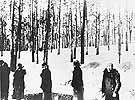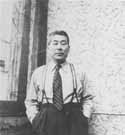
|
|
|

|

|

|

|
|
Click on an image to see a larger, more detailed picture.
|
|
|
|
|
| 1940: Machinery of Hatred |

|
pg. 189 |

|
|
|
|
| |
 In the Palmiry Woods, about 17 miles outside of Warsaw, the Germans shot approximately 2000 Poles during the first four years of the war. This photograph, taken in 1940, shows several blindfolded Polish women standing before a mass grave, awaiting their executions.
In the Palmiry Woods, about 17 miles outside of Warsaw, the Germans shot approximately 2000 Poles during the first four years of the war. This photograph, taken in 1940, shows several blindfolded Polish women standing before a mass grave, awaiting their executions.
Photo: Bildarchiv Preussischer Kulturbesitz
|
 Relieved and joyful smiles light up faces in this group of Jewish refugees, who were among the fortunate few allowed entry into Canada, a country hostile to Jewish immigration. While farmers were welcomed, those of most other occupations were not. Scholars and teachers, no matter how esteemed in their homeland, found Canada's universities unwilling to offer them posts.
Relieved and joyful smiles light up faces in this group of Jewish refugees, who were among the fortunate few allowed entry into Canada, a country hostile to Jewish immigration. While farmers were welcomed, those of most other occupations were not. Scholars and teachers, no matter how esteemed in their homeland, found Canada's universities unwilling to offer them posts.
Photo: American Jewish Joint Distribution Committee / United States Holocaust Memorial Museum Photo Archive
|
 Sempo Sugihara
Sempo Sugihara
Sempo Sugihara, the Japanese consul in Kovno, Lithuania, was one of the true heroes of the Holocaust. He rescued several thousand Jews left stranded in Lithuania after they had fled Nazi-occupied Poland. A plan devised by Zionist leaders called for the refugees to ostensibly seek asylum in Curacao, a Dutch island in the Caribbean, although there was never any intent to go there. The proposed travel route wound through the Soviet Union and Japan, necessitating transit visas. Soviet approval depended on first acquiring Japan's permission. The Japanese rejected the request. However, seeing throngs of frantic Jews clinging to the iron fences of Japan's consulate, begging for visas, roused compassion in Sugihara. Defying his government, he granted visas to as many applicants as possible--at least 3500. Ordered out of Kovno, Sugihara continued to sign papers, even as his train pulled away from the station. The refugees journeyed through Russia via the Trans-Siberian Railway to Vladivostok, and from there by boat to Japan, then China. Many eventually reached Israel or the United States. When the Germans captured Kovno in 1941, they slaughtered thousands of Jews who had not gotten out. As for Sugihara, the Japanese government cited him for insubordination and stripped him of his post.
Photo: United States Holocaust Memorial Museum Photo Archive
|
|

|

|

|

|
 1940: Leslie Hore-Belisha, Great Britain's secretary of state for war, and a Jew, resigns, largely because of the anti-Jewish feelings among members of the British government. Foreign Secretary Lord Halifax and Under-Secretary of the Foreign Office Alexander Cadogan note that Hore-Belisha's Jewishness rendered him unsuitable as minister of information, stating, "Jew control of our propaganda would be [a] major disaster."
1940: Leslie Hore-Belisha, Great Britain's secretary of state for war, and a Jew, resigns, largely because of the anti-Jewish feelings among members of the British government. Foreign Secretary Lord Halifax and Under-Secretary of the Foreign Office Alexander Cadogan note that Hore-Belisha's Jewishness rendered him unsuitable as minister of information, stating, "Jew control of our propaganda would be [a] major disaster."
|
 January 2, 1940: The Generalgouvernement in Poland decrees that Jews may not post obituaries.
January 2, 1940: The Generalgouvernement in Poland decrees that Jews may not post obituaries.
|
 January 6, 1940: Shivering Jews in Warsaw, Poland, are forced to burn Jewish books for fuel.
January 6, 1940: Shivering Jews in Warsaw, Poland, are forced to burn Jewish books for fuel.
|
 January 12, 1940: The Gestapo and SS men shoot and kill 300 inmates of a Polish insane asylum at Hordyszcze.
January 12, 1940: The Gestapo and SS men shoot and kill 300 inmates of a Polish insane asylum at Hordyszcze.
|
 January 14-16, 1940: The forced march of 880 Polish prisoners of war--all Jews--results in the shooting deaths of more than 600.
January 14-16, 1940: The forced march of 880 Polish prisoners of war--all Jews--results in the shooting deaths of more than 600.
|
|
|
|
|
| 1940: Machinery of Hatred |

|
pg. 189 |

|
|
The Holocaust Chronicle
© 2009 Publications International, Ltd.
|
|
